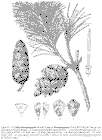
Trees in habitat, Mangshan Park, on the Hunan-Guangdong border [Pierre Mercan].

Mature tree in habitat, Mangshan Park [Pierre Mercan].

Foliage on a tree at Mangshan Park [Pierre Mercan].

A cone on an ornamental specimen in Seattle (USA) [Robert Van Pelt, 2005.05.12].

Line drawing of the type variety from the Flora of China (Wu and Raven 1999).

Conservation Status

Pinus kwangtungensis
Chun et Tsiang 1948
Common names
Thông Pà cò [Vietnamese]; 华南五针松 huanan wuzhen song (Hunan 5-needle pine) [Chinese].
Taxonomic notes
Two varieties. For the type variety, syn: Pinus wangii Hu et W. C. Cheng var. kwangtungensis (Chun et Tsiang) Silba. The second variety is Pinus kwangtungensis var. varifolia Nan Li et Y. C. Zhong, Novon 7: 262. 1997. Many authors do not treat P. kwangtungensis at the species rank, preferring to lump it with either of the closely related taxa Pinus morrisonicola of Taiwan or Pinus fenzeliana of south China and Viet Nam. In this treatment of the group, I have chosen to treat each taxon as a good species, following the line taken by the Flora of China (Wu and Raven 1999) as a recent authoritative treatment. For discussion of systematics relative to other species in subsection Strobus, see Phylogeny of East Asian white pines.
Description
Trees to 30 m tall and 150 cm dbh. Bark brown, scaly. First-year branchlets pale brown; old branchlets grayish brown or yellow-brown, glabrous, rarely puberulent. Winter buds black-brown, slightly resinous. Needles 2-5 per fascicle, triangular in cross section, 3.5-7 cm × 1-1.5 mm, vascular bundle 1, resin canals 2, marginal, sometimes also 1 medial, base with sheath shed. Seed cones usually solitary on a 7-20 m peduncle, red-brown at maturity, cylindric-oblong or cylindric-ovoid, 3-9(-17) × 1.5-7 cm, slightly resinous. Seed scales cuneate-obovate, 2.5-3.5 × 1.5-2.3 cm; apophyses rhombic, apex thin, straight or slightly incurved. Seeds ellipsoid or obovoid, 0.8-1.2 cm, together with wing subequal to seed scales. Pollination Apr-May, seed maturity Oct of second year (Wu and Raven 1999).
The two varieties can be distinguished according to the following key, here reproduced from Wu and Raven (1999):
| | | |
| 1 | Needles 5 per fascicle, with white stomatal bands abaxially; seed cones 5-9(-17) × 3-7 cm | var. kwangtungensis |
| + | Needles 2-3(-5) per fascicle, with inconspicuous stomatal bands abaxially; seed cones 3-4 × 1.5-2 cm | var. varifolia |
| | | |
Pinus wangii of Yunnan and Viet Nam is similar, but has densely pubescent branchlets and 3 medial resin canals, while P. kwangtungensis has glabrous (rarely puberulent) branchlets and 2 marginal resin canals (sometimes also 1 medial) (Wu and Raven 1999).
Distribution and Ecology
China and Viet Nam. In China, it occurs in N Guangdong, SW Guangxi, S Guizhou, Hainan, and S Hunan, at altitudes of 500-1,600 meters. It is possible that the Hainan collections actually represent the closely related P. fenzeliana (Wu and Raven 1999). In Viet Nam, it is found in Hoa Binh (Pa Co commune, Mai Chau district) and Cao Bang (Duc Hong commune, Trung Khanh district), where it is found on limestone peaks at elevations of about 1,300-1500 m. It grows in pure stands, or mixed with Chamaecyparis hodginsii and some species of Fagaceae and Lauraceae (FIPI 1996 [as P. kwangtungensis]).
Remarkable Specimens
Zuidema et al. (2011) do not provide age data, but their Figure 1 indicates a maximum age for P. kwangtungensis of about 230 years, which is a crossdated age developed with a tree-ring chronology. This is for a forest in the mountains of Viet Nam.
Ethnobotany
"Timber used by local people as good construction timber. Besides its oleo resin can be used as an adhesive. This is a very endangered tree species of Viet Nam. Due to its confined habitats, the number of individuals is not many, and the needs in construction timber and fuelwood of the tribesmen groups may cause the species to disappear; its number being strongly reduced. Rated as a vulnerable species. We need integral protection of the species in-situ (at the existing pine groves of Pa Co). Research should also be made to create plantations of the species at its range of habitats, as supplementary measures for preservation" (FIPI 1996).
As noted above, the species has been the subject of an exploratory dendrochronological study, which established the formation of annual rings, showed positive correlations between growth and precipitation, and provided some life history insights (Zuidema et al. 2011).
Observations
Remarks
Citations
Chun and Tsiang. 1948. Sunyatsenia 7: 113.
Zuidema, Pieter A., Mart Vlam, and Pham D. Chien. 2011. Ages and long-term growth patterns of four threatened Vietnamese tree species. Trees 25:29-38. https://doi.org/10.1007/s00468-010-0473-2.
See also
Hiep et al. 2004.
Luu and Thomas 2004 provide a description, range map, conservation status, drawings and photos, and a wealth of additional information.





